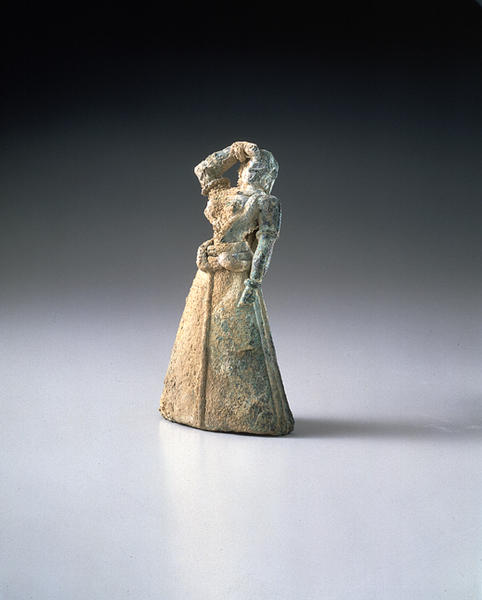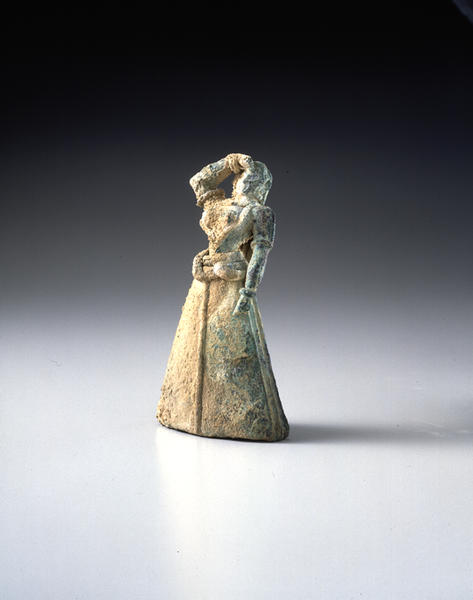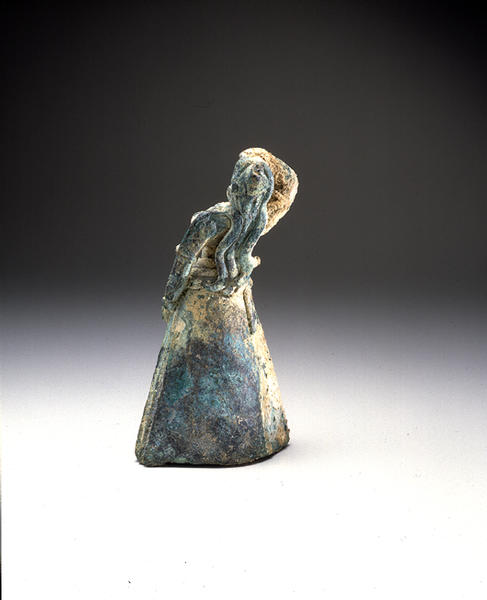Female Figure
- Eastern Mediterranean
- Aegean area,ca
- 1500 B.C.
- Bronze
- H-13.5
Catalogue Entry
This woman stands upright but bends her upper body slightly backwards as if to look up at something, holding her right hand at her forehead. Her left arm is held by her side. Her wavy hair is braided behind the head, and hangs down to reach her waist. The decorated collar of her short-sleeve shirt runs down on the side of her chest and is clasped together at her stomach. Together with her tight-fitting clothes, the overall image emphasizes her breast. A broad belt wraps around her waist three times, and is knotted on the right side. With a decorative sash hanging down the front center, she wears a flared skirt that shows pleats or gathers at both of her sides.
Small bronze figures modeled after a man or a woman like the present piece were dedicated to many temples in caves or on the summit of mountains, as well as in private homes from the mid- to late Minoan era. From scenes carved on rings at that time, the pose is apparently that of a worshipping follower of a religion whose god has just made an appearance in the sky (fig. 1).*1 Figures of this sort were all produced by the lost-wax casting method. Male figures were solid-cast, as were female figures' upper bodies. The inside of females' skirt were left empty. The present piece is hollow inside the skirt and the upper body was solid-cast. Space is left open between the hanging hair and her back. She wears large earrings, a two-fold necklace, and bracelets. Delicate and detailed expressions abound in this work, especially in the treatment of the end of the sleeves and the decorative band extending from the shoulder to the end of the sleeves.
Extant figures of this type are mostly small, within 10cm in height. The general appearance must have been the main thrust of these pieces and less interest is customarily shown in detail. The present figure, measuring 13.5cm in height, however, has features in common with those of priestesses of the same period from Crete made by faience, and with female images seen in murals excavated from the remains of temples on the Crete and Thera Islands and in the Balkan Peninsula. A female image with large earrings, such as this piece, is found in Thera murals.*2
A male figure of 19cm in height (fig. 2) in a similar posture and perhaps belonging to the same group was produced using a surprisingly delicate method in the expression of wavy hair, accessories, and muscle tone. This also has features in common with the male images seen in steatite vessels of later Minoa from Crete. The expression of physical beauty of this male figure suggests a stylistic connection to a male figure of 12cm in height and to bas-relief portrayals on gold cups from Lakonia in Greece proper.*3
Similar to this piece is a figure of a priestess, 18.4cm in height, owned by a museum in Berlin and thought to come from Troy, which is presumed to have been produced at the request of a Crete nobleman. This figure exudes sensuality, expressed by means of the full breast, flat pit of the stomach, decorative belt, and wavy hair like ones found in wall paintings of Crete and Thera.*4 It is surmised that this male figure, too, depicts a nobleman, like the images seen on steatite vessels*5 from Hagia Triada in Crete. During that time, the king's clan, including the king himself, served as priests and priestesses in ceremonies and festivals. It is therefore likely that the woman depicted here is of a very high-rank.
Catalogue Entry(Bac#010,#011)
10
Male Figure
Mid-2nd millennium B.C.
Bronze
H. 19.0 cm
11
Female Figure
Mid-2nd millennium B.C.
Bronze
H. 13.5 cm
This pair of small figures stand with their bodies tilted backward and both are seen with their left hand held down while their right hands are held up to their foreheads. The woman has wavy hair which is bound on the back of her head and hangs to the back of her hips. Her upper body is clothed in a tight-fitting short-sleeved garment, while a decorative collar extends from the neck to both sides of the chest to meet over the belly, thereby greatly emphasizing the breasts. The waist is wrapped in three layers of thick bands which are narrowly bound and fastened at the right side. The front center of her skirt is decorated with a band and the long skirt has either folds on each side or a layered hem. The male figure has long wavy hair depicted in an amazingly detailed form. He wears short pants, and is wearing shoes.
Similar small male and female figures in bronze have been found in many of the cave temples dating from the Middle Minoan to the Late Minoan period, and they were also worshipped in mountain top temples or on home altars. This form is said to represent a worshipper honoring a god appearing from above, and this interpretation was confirmed by intaglio carving found on a ring of the period.
This pair of small figures was made by the lost wax casting method, and while the male figure was solid cast, only the upper body of the female figure was solid cast, while her lower body was hollow cast. These two figures have the same kind of handling, while the detailed handling of motifs was quite rare, particularly that seen in the individual locks of hair, earrings, necklace, bracelet and decorative bands on the garments. Similar examples of female figures are generally less than 10 centimeters in height, and the majority of them do not show this attention to detailed handling of motifs.
There are many similarities in the details and styles of jewelry and clothing between this female figure and the female figures excavated on Crete, Thera, and those seen in the wall paintings excavated from the ruins of temples on the Balkan peninsula. The male figure does not exhibit the bowed body posture found on the similar bronze male figures of the Late Minoan period excavated on Crete, but his clothing, bracelets, shoes and positions of both arms are exactly the same. A male figure in the same style on a soapstone vessel comes from the Hagia Triada on Crete and it is thought that this represents a high ranking person. During this period the king and the royal family also acted as priests and priestesses in ritual events, and the resemblance of the two exhibited works to such examples leads to the thought that they were both created for high-ranking people.
Male Figure


